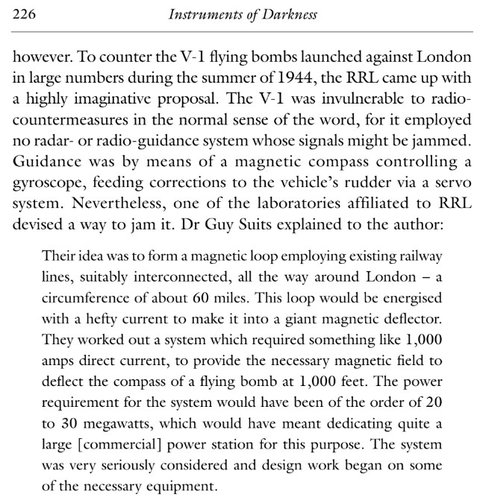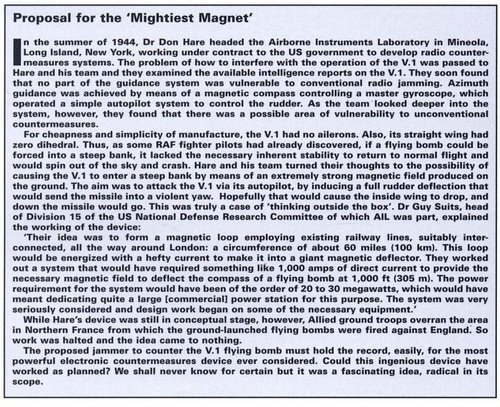xylstra
I really should change my personal text
- Joined
- 23 October 2018
- Messages
- 79
- Reaction score
- 37
KNOCKING-DOWN THE V1! "How, Oh how do we do it!?"
.... well, I'm sure we're all familiar with the usual 'suspects': the high-speed fighter intercepts, the AA batteries equipped with proximity-fused shells, barrage balloons, bombing the launch-sites, etc.......
Here's one that might have eluded you: I am given to understand that during the dark days of the V1 onslaught when there was no end in sight and no fore-knowledge of how the German attack campaign would develop and progress the government turned to the boffinss to develop a more effective and durable solution.
There answer?
They identified the V1's magnetic directional compass as being the weapon's 'Archilles Heal'. They cunningly formulated a plan to electrify all of the railway tracks lying across the V1's principal flight-path with DC current (à la similar to ships' de-gaussing coils, common at the time). Apparently at the time the V1 campaign had begun to subside with Allied invasion troops over-running the V1 launch sites some of the equipment for this counter-measures weapon was well under construction.
That's all I know on the subject ................... it's not enough!!
I want to know more: project name, names of the projects promoters and personnel, the 'whens' and the 'wheres', dates and places, technical reports and drawings, pictures, etc......
Can anyone provide further information on this most mysterious and intriguing project?
.... well, I'm sure we're all familiar with the usual 'suspects': the high-speed fighter intercepts, the AA batteries equipped with proximity-fused shells, barrage balloons, bombing the launch-sites, etc.......
Here's one that might have eluded you: I am given to understand that during the dark days of the V1 onslaught when there was no end in sight and no fore-knowledge of how the German attack campaign would develop and progress the government turned to the boffinss to develop a more effective and durable solution.
There answer?
They identified the V1's magnetic directional compass as being the weapon's 'Archilles Heal'. They cunningly formulated a plan to electrify all of the railway tracks lying across the V1's principal flight-path with DC current (à la similar to ships' de-gaussing coils, common at the time). Apparently at the time the V1 campaign had begun to subside with Allied invasion troops over-running the V1 launch sites some of the equipment for this counter-measures weapon was well under construction.
That's all I know on the subject ................... it's not enough!!
I want to know more: project name, names of the projects promoters and personnel, the 'whens' and the 'wheres', dates and places, technical reports and drawings, pictures, etc......
Can anyone provide further information on this most mysterious and intriguing project?




